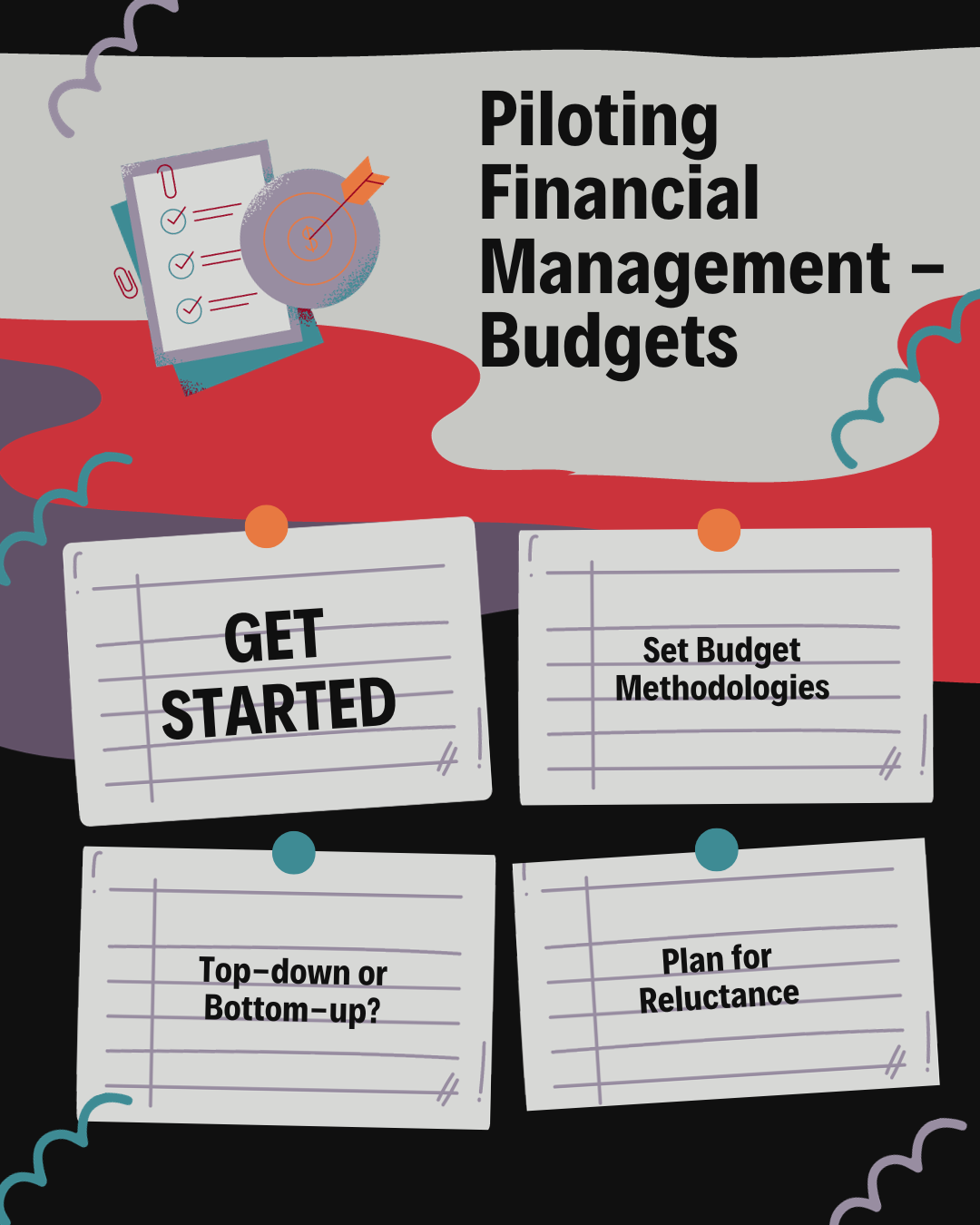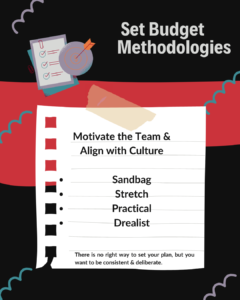Small businesses play a vital role in the economy, but they often encounter unique financial management challenges.
Particularly, during uncertain times, such as economic downturns or unexpected crises, managing finances becomes crucial for their survival and growth.
Let’s explore a process that can make a big difference.
Budgeting is a way Finance Leaders can provide scalable support for financial health.
Budgeting: A Foundation for Financial Stability
Most clients that hire our Fractional CFOs don’t have a budget. This gives our CFOs a chance for a quick win and a way to add immediate value.
Budgeting is the cornerstone of financial management for small businesses. It involves creating a comprehensive plan that outlines projected revenues and expenses over a specific period.
By setting realistic financial goals and tracking progress against them, small business owners can gain better control over their finances.
Budgeting helps identify areas where costs can be reduced, resources can be allocated more efficiently, and potential risks can be mitigated.

Budgeting lets you see what the cost of your growth is. It helps hold you and the team accountable for that growth.
And a budget can be used to set key performance indicators, bonuses, and operational improvements.
The hardest part of a budget is realizing it’s okay, if it’s not right!
The value of the process is the monitoring and the planning, and the decision-making that comes from it.
The best thing to do is get started!
Unfortunately, we may have exaggerated- it’s not “quick,” especially the first time. But it’s worth the effort and is foundational to financial health. And it’s easier than people think, mainly if you don’t aim for perfection and see it as a process & trigger instead.
Budget Methodologies
Decide if you have a stretch goal budget, a practical budget, a sandbagging budget or a drealist budget.
The methodology that you pick needs to align with the culture and the personality of your team.
Our favourite is a drealist. That’s the fine line between a dream and reality. It’s ambitious, but it’s achievable.
For example, put a little stretch into the revenue numbers but leave a lot of buffers in your costs. That’s a great way to keep motivation strong but build room for the unexpected.
A stretch budget is ambitious and unlikely to be met. It can be motivating for competitive spirits. Big Four firms and other successful, sales-driven cultures widely use it.
A sandbagging budget is easily achievable with little ambition. It’s based on historical information and trends and known adjustments. It can be practical for cash-constrained businesses with financing and capital restraints limiting goals.
These limitations aren’t within the control of operations, so it can make sense to adjust expectations. It also motivates folks who like to celebrate and see themselves excelling on expectations.
A practical budget reflects exactly what you expect. Numbers are understood and clear without any adjustments for ambitions or restraints.
Only explainable and known numbers and assumptions are leveraged. Analytical teams will thrive under a practical budget that they can recalculate and dig into.
There is no right way to set your plan. You know your people and your culture and what you want from this new tool and the mindset you are developing. Let that drive the methodology.
Don’t underestimate the importance of a deliberate choice here. Nothing is worse than one department operating with a sandbagged budget and killing results while another is monitored under a stretch plan and is tanking.
Consistency across the company is critical.
Top-down or Bottom-up?
By and large, budgets are built from the bottom up, with the most extreme example being that operations prepare and set their numbers.
The benefit of bottom-up is that you get buy-in, operations learn their numbers and can hold the team accountable at a very detailed level.
The challenge is you need to ensure that the methodology is intact. It would help if you confirmed that the operations know their numbers and the interdependencies, economics and factors that can materially impact a budget.
Make no mistake; a bottom-up budget is not less work or less involved for the accounting team! Quite the opposite, as collaboration and time working together can be excessive.
Another challenge is review and approval. If you don’t set clear expectations and instead give feedback and changes that result in the team not feeling they own the final result, it will be tough.
All the benefits of the buy-in and learning can be harshly reversed when the process isn’t respectful or well understood.

The roles and responsibilities of management, operations and accounting should be outlined and discussed.
Top-down budgets are often more efficient and require less involvement.
The apparent downside is buy-in.
When you push expectations on people, it can mean they don’t take it seriously, they don’t understand it, and they don’t believe in it.
You can expect in extreme cases that when you ask about variances to budget that the reply could be, “I don’t know. I don’t understand the budget number. You set it. You tell me?”
To have a top-down budget that holds people accountable, you can use the process to increase understanding. There’s room to be still collaborative and get feedback in the process.
Indeed, there are many hybrid options too. Accounting and Finance driven budgets are also typical.
One quick tip is for the first year – do top down!
Let the team hate it and find flaws. “It’s easier to criticize than create!” is a Linda Rappoport quote we love.
Here’s another use for it. Follow up the second year with a bottom-up or hybrid approach. Now that they’ve seen the purpose & hated the first attempt, they may be more inspired to get into the weeds and add value!
If it’s a team’s first-time budgeting and they haven’t been exposed to monitoring results, you are likely taking on a massive project starting bottom-up.
The process you introduce in year one doesn’t have to be the one you stick to. It’s often better to improve the process once you have the experience and feedback to lean on.
Too often, as business leaders, we bite off more than we can chew and try to get it right the first time. It paralyzes us, and instead, we sometimes need a bias for action.
Perfection for an internal financial strategy initiative will not help you grow.
Reluctance
Do not set a budget and forget it! What a waste of time.
You need to monitor the budget monthly.
Start easy – meet and look at your results compared to budget and compared to the prior year.

Ask the following questions:
- Are we on track?
- Are we seeing a trend?
- Is there any risks to be aware of?
- Is there any opportunity we need to identify?
- Will we hit the budget this quarter?
- Will we hit the budget for the year?
- What actions do we need to take?
As you get more sophisticated, you can have operations detail and explain all budget variances.
And you can roll the budget into a forecast soon too.
Once you are ready for forecasts, the most straightforward starting point is always actuals + budget + adjustments. So, if you just finished the first quarter, you’d take January & February & March actuals + the budget from April-December.
Once that’s illustrated, you make any known adjustments, for example, if inventory costs are tending at 5% more due to economic circumstances that can’t be avoided and are expected for the remainder of the year, but not planned during the budget.
Or if you hired a material role, you’d put that salary in as an adjustment.
See, when you have a budget, most of the hard work is done!
But start slow! The seven questions, especially the bias for data-driven action, are a new mindset and tool. It’s going to make a difference, so lean into it. Hold off on the rest until you find your flow with monitoring monthly.
Financial management is a critical aspect of running a successful small business.
By implementing effective budgeting, small business owners can navigate economic challenges and ensure long-term sustainability.
Proactive financial management not only helps companies to survive uncertain times but also positions them for growth and success in the future.
Get the latest on business leadership delivered to your inbox every week!



Leave A Comment
You must be logged in to post a comment.